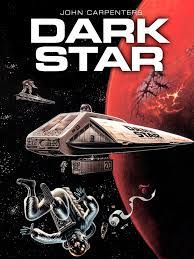
In the 22nd Century, mankind is colonizing interstellar space. The scout ship Dark Star searches out unstable planets that might threaten colonization and destroys them with an artificially intelligent thermonuclear device. Twenty years on, Dark Star has aged ungracefully and malfunctions a lot. Commander Powell (voice of John Carpenter) is dead but remains in cryogenic suspension. Lieutenant Doolittle (Brian Arelle), a former Malibu surfer, is now commander. The crew—Pinback (Dan O’Bannon), Boiler (Cal Kuniholm) and Talby (Andreijah Pahich) are pretty much insane.
Pinback plays a lot of practical jokes, has a video diary, and has adopted a beach-ball of an alien who keeps escaping from the storage room. It tries to push him down an elevator shaft and Pinback deflates and kills it with a dart-gun. He says he’s really Bill Froug and Pinback has committed suicide.
On the way to the Veil Nebula, the Dark Star encounters space-storm electromagnetic energy, causing another malfunction. The bomb receives a false order to deploy, but the ship’s computer talks it down. Doolittle wakes up the dead Commander Powell, who suggests he teach the bomb phenomenology. He space-walks to debate it and the bomb agrees to disarm itself for now.
Pinback opens the lock for Doolittle, but accidentally ejects Talby with a spacesuit but no maneuvering device. Doolittle goes off after him. The bomb, having learned Cartesian doubt, trusts only itself, as it is the only thing it can be sure exists. It is alone in the universe. Let there be light. It explodes and Dark Star is destroyed, killing Pinback and Boiler. Talby and Doolittle, out in space, are thrown clear. Talby drifts into the fascinating Phoenix Cluster and Dolittle surfs into the atmosphere on a chunk of debris and dies as a falling star.
The film was directed and produced by John Carpenter, written by him and Dan O’Bannon. As a University of Southern California film-student, O’Bannon sketched much of the movie on a napkin at the International House of Pancakes. It was Carpenter’s and O’Bannon’s first film. Carpenter was producer and wrote the music. O’Bannon was editor, production designer, and visual effects supervisor. It began as a 45-minute film on 16 mm for a thousand dollars. The ending was stolen from Ray Bradbury’s story Kaleidoscope in The Illustrated Man. Later, fifty minutes was added, including my favorite part, the beach-ball alien.
O’Bannon’s friend John Landis showed it to producer Jack Harris, who edited it a bit. O’Bannon famously said, “The world’s most impressive student film became the world’s least impressive professional film.” The way stars in space turned into streaks of light is credited as the first such depiction of the jump to hyperspace in film, later used in Star Wars and every other movie since. Roger Ebert said it was “One of the damnedest science-fiction films I’ve ever seen.” The beachball with claws was later re-worked by Dan O’Bannon into Alien. The electronic devices on the ship were ice-cube trays, children’s toys, 8-track tape, a muffin tray, Styrofoam packing, vacuum-cleaner hoses, and tin foil. The deep-frozen dead speaking through an electronic device was inspired by various works of Philip K Dick. A piece of debris from the exploded ship is labelled Toilet Tank THX-1138, referencing another little student film.
